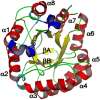Applications of Microbial β-Mannanases
- PMID: 33384989
- PMCID: PMC7770148
- DOI: 10.3389/fbioe.2020.598630
Applications of Microbial β-Mannanases
Abstract
Mannans are main components of hemicellulosic fraction of softwoods and they are present widely in plant tissues. β-mannanases are the major mannan-degrading enzymes and are produced by different plants, animals, actinomycetes, fungi, and bacteria. These enzymes can function under conditions of wide range of pH and temperature. Applications of β-mannanases have therefore, been found in different industries such as animal feed, food, biorefinery, textile, detergent, and paper and pulp. This review summarizes the most recent studies reported on potential applications of β-mannanases and bioengineering of β-mannanases to modify and optimize their key catalytic properties to cater to growing demands of commercial sectors.
Keywords: bioengineering; hemicellulose; heterologous production; industrial applications; microbial β-mannanase.
Copyright © 2020 Dawood and Ma.
Conflict of interest statement
The authors declare that the research was conducted in the absence of any commercial or financial relationships that could be construed as a potential conflict of interest.
Figures





Similar articles
-
Mannanases: microbial sources, production, properties and potential biotechnological applications.Appl Microbiol Biotechnol. 2012 Mar;93(5):1817-30. doi: 10.1007/s00253-012-3887-5. Appl Microbiol Biotechnol. 2012. PMID: 22314515 Review.
-
Research and application progress of microbial β-mannanases: a mini-review.World J Microbiol Biotechnol. 2024 Apr 17;40(6):169. doi: 10.1007/s11274-024-03985-1. World J Microbiol Biotechnol. 2024. PMID: 38630389 Review.
-
Thermophilic β-mannanases from bacteria: production, resources, structural features and bioengineering strategies.World J Microbiol Biotechnol. 2024 Mar 9;40(4):130. doi: 10.1007/s11274-024-03912-4. World J Microbiol Biotechnol. 2024. PMID: 38460032 Review.
-
Microbial mannanases: an overview of production and applications.Crit Rev Biotechnol. 2007 Oct-Dec;27(4):197-216. doi: 10.1080/07388550701775919. Crit Rev Biotechnol. 2007. PMID: 18085462 Review.
-
Alkaline Active Hemicellulases.Adv Biochem Eng Biotechnol. 2020;172:245-291. doi: 10.1007/10_2019_101. Adv Biochem Eng Biotechnol. 2020. PMID: 31372682
Cited by
-
High NaCl concentrations induce the resistance to thermal denaturation of an extremely halotolerant (salt-activated) β-mannanase from Bacillus velezensis H1.World J Microbiol Biotechnol. 2023 Sep 11;39(11):304. doi: 10.1007/s11274-023-03754-6. World J Microbiol Biotechnol. 2023. PMID: 37691038
-
Identification and Characterization of a Novel Mannanase from Klebsiella grimontii.Bioengineering (Basel). 2023 Oct 21;10(10):1230. doi: 10.3390/bioengineering10101230. Bioengineering (Basel). 2023. PMID: 37892960 Free PMC article.
-
Effect of dietary β-mannanase supplementation on growth performance, digestibility, and gene expression levels of Cyprinus carpio (Linnaeus) fingerlings fed a plant protein-rich diet.Front Vet Sci. 2022 Sep 2;9:956054. doi: 10.3389/fvets.2022.956054. eCollection 2022. Front Vet Sci. 2022. PMID: 36118353 Free PMC article.
-
Expression of mannanase and glucanases in lettuce chloroplasts and functional evaluation of enzyme cocktail against Candida albicans in oral cancer patient samples.Plant Biotechnol J. 2025 Jul;23(7):2689-2703. doi: 10.1111/pbi.70046. Epub 2025 Apr 18. Plant Biotechnol J. 2025. PMID: 40251764 Free PMC article.
-
Optimized production and characterization of endo-β-mannanase by Aspergillus niger for generation of prebiotic mannooligosaccharides from guar gum.Sci Rep. 2024 Jun 18;14(1):14015. doi: 10.1038/s41598-024-63803-4. Sci Rep. 2024. PMID: 38890382 Free PMC article.
References
-
- Abd Rashid J. I., Samat N., Yusoff W. M. W. (2012). Screening and optimization of medium composition for mannanase production by Aspergillus terreus SUK-1 in solid state fermentation using statistical experimental methods. Res. J. Microbiol. 7:242 10.3923/jm.2012.242.255 - DOI
-
- Adiguzel G., Sonmez Z., Adiguzel A., Nadaroglu H. (2016). Purification and characterization of a thermostable endo-beta-1, 4 mannanase from Weissella viridescens LB37 and its application in fruit juice clarification. Eur. Food Res. Technol. 242 769–776. 10.1007/s00217-015-2584-x - DOI
Publication types
LinkOut - more resources
Full Text Sources

